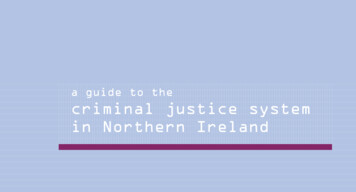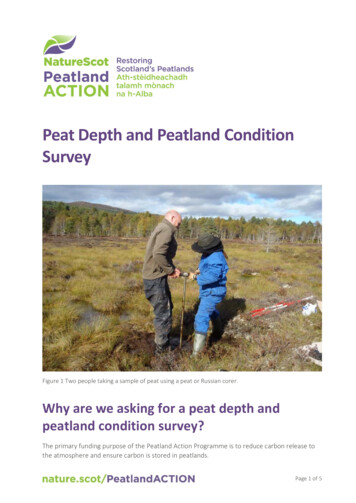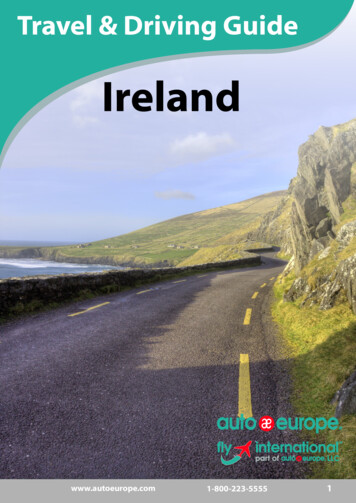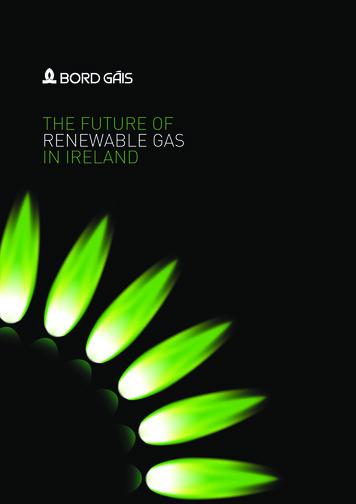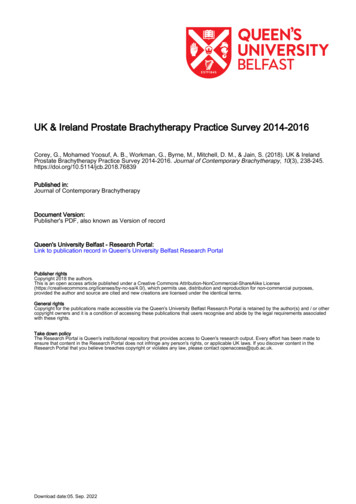
Transcription
Research and Information ServiceBriefing PaperPaper No. 32/2105 May 2021NIAR 117-2021Peat and PeatlandsJosh PikeThis briefing paper provides information on peat and peatlands across the UK and theRepublic of Ireland. It discusses the current extent and conditions of peatlands acrossthe jurisdictions and natural capital and ecosystem services provided by peatlands. Thevarious jurisdictions’ national peatland strategies are outlined and peatland restorationefforts are discussed. The role peatlands play in climate change targets are examinedand finally future considerations are detailed.
NIAR 117-2021Briefing PaperContentsContents . 21What is peat? . 42What are peatlands? . 43Current extent and condition of peatlands in the UK . 43.1Northern Ireland . 53.2England . 73.3Scotland. 93.4Wales . 113.5Republic of Ireland . 134Natural capital and ecosystem services . 154.1Peat extraction . 154.2Agriculture . 164.3Carbon sequestration and storage . 174.4Drinking water . 194.5Biodiversity . 195National Peatland Strategies . 215.1The UK peatland strategy 2018-2040 . 215.2Northern Ireland . 215.3England . 225.4Scotland. 225.5Wales . 235.6Republic of Ireland . 2367Peatland restoration . 246.1Northern Ireland . 246.2England . 256.3Scotland. 266.4Wales . 266.5Republic of Ireland . 276.6The Peatland Code . 28Peatlands and climate change targets . 28Providing research and information services to the Northern Ireland Assembly2
NIAR 117-20218Briefing PaperFuture considerations . 30Annex 1 – IUCN UK Peatland Strategy 2018-2040 . 33Providing research and information services to the Northern Ireland Assembly3
NIAR 117-2021Briefing Paper1 What is peat?Peat is an organic surface layer within soils, which is comprised of partiallydecomposing organic material (predominately from plants). The organic material doesnot fully decompose due to waterlogging, oxygen and nutrient deficiency, and highacidity conditions found in peatlands1.2 What are peatlands?Peatlands are terrestrial wetland ecosystems, which have a net accumulation of peat2.The Ramsar Convention defined peatlands as3:“Peatlands are ecosystems with a peat deposit that may currently supporta vegetation that is peat-forming, may not, or may lack vegetation entirely”Peatlands cover 3% of the global land surface yet they are the largest naturalterrestrial store of carbon, 450 gigatonnes CO2 equivalent (GtCO2e), and annuallysequester 0.4 billion tons of CO24.There are three broad peatland habitats in the UK5; Blanket bog – peatlands which receive all their water from precipitation. Theyare globally rare, but are the largest UK peatland habitat;Raised bog – peatlands which form in low lying areas, typically floodplains orbasins. They are often found on the surface of fens, and can be identified bytheir domes of peat;Fens – peatland environments that receive their water from precipitation andgroundwater. There are a wide variety of fen-environments.Additionally peatlands may also be classified as ‘upland’ and ‘lowland’.3 Current extent and condition of peatlands in the UKPeatlands occupy 12% of the UK land area, provide over a quarter of the UK’s drinkingwater6, and is the largest component of the UK’s wetland environment. Table 1provides a summary of the UK’s peatland habitats. Current estimates suggest that only20% of the UK’s peatlands remain in a near-natural state7. However, there is currentlyno consistent reference year or scale8 for peatland extents and conditions across theUK and much of the peat and peatland data is becoming increasing aged (i.e. National1International Peatland Society; https://peatlands.org/peat/ [last accessed 04/05/2021]International Peatland Society. https://peatlands.org/peatlands/ [last accessed 04/05/2021]3Ramsar Convention (2002) Resolution VIII.11: Additional guidance for identifying and designating under-represented wetlandtypes as Wetlands of International Importance, p.44HM Treasury (2021), Final report - The Economics of Biodiversity: The Dasgupta Review, p.1255ONS (2019) UK natural capital: peatlands6ibid7IUCN (2018) UK Peatland Strategy 2018-20408England and Wales use a peat depth of 40cm , Scotland and Northern Ireland use a peat depth of 50cm 2Providing research and information services to the Northern Ireland Assembly4
NIAR 117-2021Briefing PaperSoil Map compiled by Joint Nature Conservation Committee (JNCC) in 20119). Thismakes it difficult to assess peat and peatland change over time, and across the UK.Table 1. Summary of UK peatland habitats. Source: CEH (2017) Implementation of an EmissionsInventory for UK actedTotal 44,8872,962,626Percentage71586515100Northern IrelandThe JNCC National Soil Map10 indicates that 24.6% of NI is covered by peat. A newpeat map was developed by the Centre for Ecology and Hydrology (CEH) in 2017based on the British Geological Survey (BGS) superficial geology dataset, the AgriFood and Biosciences Institute (AFBI) soil survey, and the 1988 NI peat survey11. TheCEH mapping identified a total peat extent of 242,622 ha12 (figure1).It is estimated that 86% of NI’s peatlands are in a degraded state due to drainage,overgrazing, afforestation, burning and extraction13. Table 2 provides a summary of thepeatland habitats in NI and their condition.Table 2. Summary of peatland categories and conditions in NI. A baseline of 2007 was used. Source:CEH (2017) Implementation of an Emissions Inventory for UK Peatlands.Peatland habitat and condition (NI 2007)ForestCroplandDrained eroded modified bogUndrained eroded modified bogDrained heather dominated modified bogUndrained heather dominated modified bogDrained grass dominated modified bogUndrained grass dominated modified bogExtensive grasslandIntensive grasslandNear natural bogNear natural .49%0.80%12.88%14.80%0.00%9JNCC (2011) Report No. 445: Towards an assessment of the state of UK Peatlandsibid11Cruikshank and Tomlinson (1990) 1988 Northern Ireland Peat Survey12CEH (2017) Implementation of an Emissions Inventory for UK Peatlands. A report to the Department for Business, Energyand Industrial Strategy p.2413RSPBNI (2020) Peatland restoration is vital if Northern Ireland is serious about a green recovery [last accesses 04/05/2021]10Providing research and information services to the Northern Ireland Assembly5
NIAR 117-2021Extracted domestic peatExtracted industrial peatRewetted bogRewetted fenTotal (ha)Briefing Paper36.08%0.22%2.07%0.14%242,623Figure 1. Peat extent in Northern Ireland. Source: CEH (2017) Implementation of an Emissions Inventoryfor UK Peatlands.Providing research and information services to the Northern Ireland Assembly6
NIAR 117-20213.2Briefing PaperEnglandPeatlands cover 11% of England’s land area14 covering some 682,230 ha15 (figure 2).Around 30% of England’s peatland are in a wasted state (heavily degraded throughdrainage and cultivation for agriculture)16.Less than 1.3% of England’s peatlands are in a near-natural state due to considerablepeat extraction, grazing, fire and drainage for agriculture, and forestry plantations17.Table 3 provides a summary of the peatland habitats in England and their condition.Table 3. Summary of peatland categories and conditions in England. A baseline of 2013 was used.Source: CEH (2017) Implementation of an Emissions Inventory for UK Peatlands.Peatland habitat and condition (England 2013)ForestCroplandDrained eroded modified bogUndrained eroded modified bogDrained heather dominated modified bogUndrained heather dominated modified bogDrained grass dominated modified bogUndrained grass dominated modified bogExtensive grasslandIntensive grasslandNear natural bogNear natural fenExtracted domestic peatExtracted industrial peatRewetted bogRewetted fenTotal 2,20114Natural England (2021) Report NERR094; Carbon storage and sequestration by habitat: a review of the evidence (secondedition) p.9915CEH (2017) Implementation of an Emissions Inventory for UK Peatlands. A report to the Department for Business, Energyand Industrial Strategy p.2216ibid17ibidProviding research and information services to the Northern Ireland Assembly7
NIAR 117-2021Briefing PaperFigure 2. Peat extent in England; Red peat, Orange wasted peat. Source: CEH (2017) Implementationof an Emissions Inventory for UK Peatlands.Providing research and information services to the Northern Ireland Assembly8
NIAR 117-20213.3Briefing PaperScotlandPeatlands cover more than 20% of Scotland’s land18, and there are four main naturalpeatland types in Scotland; blanket bog, raised bog, fen and bog woodland19. Blanketbogs are the most extensive peatland habitat in Scotland covering 1.8 million hectares(23% Scotland land area), storing an estimated 1.6 billion tonnes of carbon20.It is estimated that 70% of Scottish blanket bogs and 90% of Scottish raised bogs havebeen damaged in some capacity21.CEH noted that there was a lack of high resolution data available for mapping peatsoils22, inhibiting the ability to exactly locate peat deposits. Combining differentmapping data sources CEH produced the first unified map of peat presence/absencefor Scotland. The total mapped peat area for Scotland was 1,947,750 ha23 (figure 3).Table 4 provides a summary of the peatland habitats in Scotland and their condition.Table 4. Summary of peatland categories and conditions in Scotland. A baseline of 1990 was used.Source: CEH (2017) Implementation of an Emissions Inventory for UK Peatlands.Peatland habitat and condition (Scotland 1990)ForestCroplandDrained eroded modified bogUndrained eroded modified bogDrained heather dominated modified bogUndrained heather dominated modified bogDrained grass dominated modified bogUndrained grass dominated modified bogExtensive grasslandIntensive grasslandNear natural bogNear natural fenExtracted domestic peatExtracted industrial peatRewetted bogRewetted fenTotal 947,750Scottish Natural Heritage (2015) Scotland’s National Peatland Plan: Working for our futureibid20ibid21ibid22CEH (2017) Implementation of an Emissions Inventory for UK Peatlands. A report to the Department for Business, Energyand Industrial Strategy p.20-2123ibid1819Providing research and information services to the Northern Ireland Assembly9
NIAR 117-2021Briefing PaperFigure 3. Peat extent in Scotland. Source: CEH (2017) Implementation of an Emissions Inventory for UKPeatlands.Providing research and information services to the Northern Ireland Assembly10
NIAR 117-20213.4Briefing PaperWalesAt least 4% of Wales is covered by peatland24, in both upland and lowland settings.Wales supports the largest expanses of near-natural blanket mire in GB25.The total mapped peat area for Wales was 90,050 ha26 (figure 4). Table 5 provides asummary of the peatland habitats in Wales and their condition. There is limited data forthe condition of Welsh peatlands. CEH reported that 23,548 ha (26%)27 of Welshpeatlands were in a near-natural state, therefore 74% of Welsh peatlands have beendamaged to some extent.Table 5. Summary of peatland categories and conditions in Wales. A baseline of 1990 was used. Source:CEH (2017) Implementation of an Emissions Inventory for UK Peatlands.Peatland habitat and condition (Wales 1990)ForestCroplandDrained eroded modified bogUndrained eroded modified bogDrained heather dominated modified bogUndrained heather dominated modified bogDrained grass dominated modified bogUndrained grass dominated modified bogExtensive grasslandIntensive grasslandNear natural bogNear natural fenExtracted domestic peatExtracted industrial peatRewetted bogRewetted fenTotal 05224Natural Resources Wales (2020) National Peatland Action Programme, 2020-2025ibid26CEH (2017) Implementation of an Emissions Inventory for UK Peatlands. A report to the Department for Business, Energyand Industrial Strategy p.2327ibid25Providing research and information services to the Northern Ireland Assembly11
NIAR 117-2021Briefing PaperFigure 4. Peat extent in Wales. Source: CEH (2017) Implementation of an Emissions Inventory for UKPeatlands.Providing research and information services to the Northern Ireland Assembly12
NIAR 117-20213.5Briefing PaperRepublic of IrelandPeat soils cover 21% of the RoI, with a total peatland area of 1,564,650 hectares28(figure 5). RoI has a comparable peatland coverage to Scotland.It is estimated that only 10% of raised bogs and 28% of blanket bogs are in a naturalstate29.Table 6 provides a summary of the peatland habitats in RoI and their condition.Table 6. Summary of peatland categories and conditions in RoI. Source: Department of Arts, Heritage andthe Gaeltacht (2015) Managing Ireland’s Peatlands: A National Peatlands Strategy 2015Peatland habitat and condition (RoI)Natural peatlandsCutover peatlands (domestic turf cutting)Afforested peatlandsFarmed grasslandsIndustrial cutaway peatlandsRehabilitated cutawaysTotal 564,650Department of Arts, Heritage and the Gaeltacht (2015) Managing Ireland’s Peatlands: A National Peatlands Strategy 2015, p.429ibid28Providing research and information services to the Northern Ireland Assembly13
NIAR 117-2021Briefing PaperFigure 5. Peat extent in RoI. Data source: RoI EPA Irish Soil Information System National Geodatabase(1:250,000), available at https://gis.epa.ie/GetData/DownloadProviding research and information services to the Northern Ireland Assembly14
NIAR 117-20214Briefing PaperNatural capital and ecosystem servicesNature provides the building blocks to sustain life on earth, these goods and servicescan be thought of in two ways, as natural capital and ecosystem services.Natural capital places monetary values on assets provided by nature by examining theflow of services provided to people alongside the benefit to society and the cost (orprofit) of the service30.Ecosystem services are the assets that nature provides to humans. Peatlands provideand regulate a wide variety of ecosystem services31, which are themselves affected bythe health of the peatland.The value of these assets can be used to create natural capital accounts for differentecosystems.Below are examples of peatland ecosystem services.4.1Peat extractionPeat continues to be industrially extracted predominately for horticulture usage in theUK32. This industrial extraction adds to the UK economy, however income fromindustrial extraction has declined from 119m in 1997 to 36.2m in 201533. CEH(2017) estimated the change in peatland extraction between 1990 and 2013 (table 7).Table 7. Area of industrial and domestic peat extraction sites by country in 1990 and 2013. Domesticextraction refers to peat cuttings on blanket bogs for fuel. Industrial extraction refers to cuttings on fensand raised bogs for predominately horticultural use. Source: CEH (2017) Implementation of an EmissionsInventory for UK 19902013DomesticextractionEngland (ha)Scotland eland (ha)76150392,20287,539Bord na Móna, RoI announced in 2021 that it had formally ended all peat harvestingon its land after having suspended harvesting in 202034. However, Bord na Móna willcontinue to manufacture peat briquettes to 2024, and continue to operate itshorticultural facility supported by existing peat reserves35.The UK Government stated in its 25-year environment plan its intention to cease peatin horticultural products by 2030. Additionally in 2010, the then Natural Environment30ONS (2019) UK natural capital: peatlandsEcosystem services are the benefits provided by an ecosystem to people32ONS (2019) UK natural capital: peatlands33Total income based on 2017 prices; ONS (2019) UK natural capital: peatlands34Bord na Móna (2021) Bord na Móna announce formal end to all peat harvesting on its lands [last accessed 04/05/2021]35ibid31Providing research and information services to the Northern Ireland Assembly15
NIAR 117-2021Briefing PaperMinister Richard Benyon stated his intention to eliminate peat from the amateur marketby 202036, and although this target was voluntary, it was not met.A group of gardening experts, conservationists and scientists wrote to the DEFRAminister George Eustice in April 2021, asking the UK to take leadership of the issue,and ban the sale of peat compost by the end of 202137.The Wildlife Trust survey of leading garden retailers and their use of peat basedproducts found that of those who responded (11 out of 20), all offer peat-free compostsin their ranges and none sell soil improvers or mulch containing peat. But only TravisPerkins and Wickes declared an end-date for peats sales (2021 and 2025respectively). B&Q, Hillier and the Blue Diamond group committed to phase out peatsales but gave no date, whereas Asda, Lidl and others have set targets to reduce peatsales but not to end sale. Additionally Asda committed to ending sale of their ownbrand peat products by 2030.In NI, the power to grant permission for industrial peat extraction lies with the planningauthorities. DAERA is a statutory consultee, but does not hold information on thelocation or current and projected extraction rates from approved sites38.4.2AgricultureAgriculture is one of the most common uses of peatlands. It is estimated that 7% of theUK’s total peatland is being used as cropland39, with the vast majority of farmedpeatland in England40. To enable peatlands to be used for agricultural purposes,modification needs to occur, typically in the form of cutting drainage channels. Thisleads to peat wastage of 10-30 mm per year41.38% of England’s lowland peatlands are currently managed for intensive agriculture42,and are highly profitable. 90% of East Anglian farmlands are on fens, they make upless than 4% of England’s farmed area but contribute more than 7% of the totalagricultural production, worth 1.23bn to the UK economy43.However, 7600 kilotonnes CO2 per year (ktCO2 yr-1) are estimated to be emitted fromfarmed peatlands, or 32% of all greenhouse gas emissions from peatlands44.36DEFRA (2010) Press release: Government calls for peat to be phased outPeatfree (2021) Letter to Secretary of State for the Environment, Food and Rural Affairs [last accessed 04/05/2021]38Northern Ireland Assembly (2021) DAERA Minister’s answer to written question 16008/17-22. Available spx39Office for National Statistics July 2019; UK natural capital: peatlands40CEH (2017) Implementation of an Emissions Inventory for UK Peatlands. A report to the Department for Business, Energyand Industrial Strategy41Graves and Morris (2013) Restoration of fen peatland under climate change. Report to the adaptation sub-committee of theCommittee on Climate Change42DEFRA (2020) England Peat Strategy: Policy Discussion Document43ibid44CEH (2017) Implementation of an Emissions Inventory for UK Peatlands. A report to the Department for Business, Energyand Industrial Strategy37Providing research and information services to the Northern Ireland Assembly16
NIAR 117-2021Briefing PaperThe Committee on Climate Change (CCC) has advised NI that there will need to be asubstantial change in farming approaches, allowing greater forestation as well as anincrease in lower carbon intensive practices45 to reduce emissions in the agriculturalsector.4.3Carbon sequestration and storageIt is vital to understand the condition of peatlands as they are capable of being majorcarbon stores for thousands of years. However, peatlands in a poor condition turn frombeing net carbon sinks to net carbon sources. Table 8 shows the impact of peatlanddegradation on greenhouse gas emissions.A near natural bog can remove 3.5 tonnes CO2 per hectare per year (tCO2 ha-1 yr-1),whereas a near natural fen can remove 5.5 tCO2 ha-1 yr-146. Therefore the 20% of UKpeatlands in a near natural state, are currently sequestering 1800 ktCO2 yr-1. Theremaining 80% of peatlands in various stages of degradation will either be reducingthe amount of carbon it can sequester or becoming carbon sources, emitting theirstored carbon.It is estimated that UK peatlands currently store more than 3 billion tonnes of carbon,this is same as all carbon stored in the forests of the UK, Germany and Francecombined47.There is debate about how peatlands will respond to climate change48. Scientists areable to extract information about how peatlands responded to past climatic changes byinvestigating deep peat deposits. Much of the peat deposited in the UK has beenforming since the last ice age, enabling a record of the past 10,000 years. These pastclimate records indicate that at high-latitudes peatlands will increase their carbonsequestration capacity, as long as they are not degraded49. This would create a‘negative feedback’ whereby peatlands take in carbon reducing future warming.45CCC (2019) Reducing emissions in Northern IrelandCEH (2017) Implementation of an Emissions Inventory for UK Peatlands. A report to the Department for Business, Energyand Industrial Strategy47BBC (2020) Climate Change: UK peat emissions could cancel forest benefits [last accessed 04/05/2021]48Loisel, L et al., (2021) Expert assessment of future vulnerability of the global peatland carbon sink. Nature Climate Change,11, p. 70-7749Gallego-Sala, A et al., (2018) Latitudinal limits to the predicted increase of the peatland carbon sink with warming. NatureClimate Change, 8, p. 907-91346Providing research and information services to the Northern Ireland Assembly17
NIAR 117-2021Briefing PaperTable 8. Emission factors for peat condition types (all measured in tCO2e ha-1 yr-1). Note that negative(positive) values indicates net greenhouse gas removal (emission). A. Tier 1 default emission factor; B.Tier 2 emission factor; C. Tier 3 emission factor (CARBINE model 1990-2019 implied factor). Source:Natural England (2021) Report NERR094; Carbon storage and sequestration by habitat: a review of theevidence (second edition) p.105PeatconditionDrainagestatusDirectCO2a,b,cCO2 fromdissolvedorganiccarbon a1.14CO2 mditchesaDirectN2Oa,bTotalForestDrained2.52 ngmodifiedbog (barepeat)Modifiedbog (seminaturalHeatherand grassdominated)Extensivegrassland(bog ural 1Providing research and information services to the Northern Ireland Assembly18
NIAR 117-20214.4Briefing PaperDrinking waterUp to 70% of UK drinking water is sourced from peatland dominated uplandcatchments50. Most of these catchments have been subjected to drainage, forestryplantation and burn-management, leading to the degradation of peatlands causing, orat least aiding, the increase of dissolved organic carbon (DOC) within UK water51.DOC levels in water are important for water treatment. Higher levels of DOC causecolour (brown water), odour and taste issues, require increasing water treatment. Overthe last 30 years, DOC levels have doubled in many UK catchments52, and evidencehas found that typical treatment methods used in the UK are becoming less efficient,increasing costs, and potential creating the need for new treatment procedures53.Many UK water companies have begun prioritising investment in peatland restorationto aid in reducing treatment costs; 4.5United Utilities have invested 10.6m across 27,000 hectares through itsSustainable Catchment Management Programme (SCaMP); andThe Source to Tap INTERREG VA funded ( 4.9m) forest-to-peatlandrestoration project is being led by NI Water. The project at Tullychurry aims torestore 32 ha of previous commercial conifer plantation to a functioning bog.The project is funded by the European Union’s INTERREG VA programme,DAERA, and the Department for Housing, Planning and Local Government, inthe RoI. The project is due to finish in 2021.BiodiversityPeatlands are home to a wide variety of habitats, plants and animals, some of whichare designated as rare, threatened or in decline. Species that are in decline, rareand/or of UK/all-Ireland importance may be designated a priority species.The Northern Ireland Priority Species List is currently under review by DAERA, withthe revised Priority Species list available in stages (spring 2020, autumn 2020, andpotentially additional phase in 202154). The current Priority Species list published in2010 include many species reliant on peatlands, these include; Dunlin (bird);Golden Plover (bird), estimated only 10-20 breeding pairs are left in NI55;Natural England (2009) NE209: Mapping values: the vital nature of our uplands – an atlas linking environment and peopleWilliamson, J et al., (2020) Will UK peatland restoration reduced dissolved organic matter concentrations in upland drinkingwater supplies? Hydrology and Earth System Sciences Discussion [preprint]52Yallop, A. et al., (2010) Increase in humic dissolved organic carbon export from upland peat catchments: the role oftemperature, declining sulphur deposition and changes in land management. Climate Research, 45, p. 43-5653Worral, F and Burt, T (2009) Changes in DOC treatability: indications of compositional changes in DOC trends. Journal ofHydrology, 366 p.1-854DAERA, Northern Ireland Priority Species [last accessed 04/05/2021]55Ulster Wildlife, Wildlife of our Peatlands [last accessed 04/05/2021]5051Providing research and information services to the Northern Ireland Assembly19
NIAR 117-2021 Briefing PaperHen Harrier (bird), NI supports the only tree nesting population in the world56;Large Heath (butterfly);Desmoulin’s whorl snail (mollusc), identified in 2018 for the first time in NI57;Bog rosemary (vascular plant); andMarsh saxifrage (vascular plant)Peatland habitats in the UK are often protected by statutory designations to protectrare animals, plants, or geological features (table 9). Peatlands may be designated asSpecial Areas of Conservation (SACs), Site of Special Scientific Interest (SSSI) in GB,Areas of Special Scientific Interest (ASSI) in NI, and Ramsar.SACs are protected sites under the European Council’s Habitats Directive(92/43/EEC), and in the UK this is d
CEH noted that there was a lack of high resolution data available for mapping peat soils22, inhibiting the ability to exactly locate peat deposits. Combining different mapping data sources CEH produced the first unified map of peat presence/absence for Scotland. The total mapped peat area for Scotland was 1,947,750 ha23 (figure 3).
